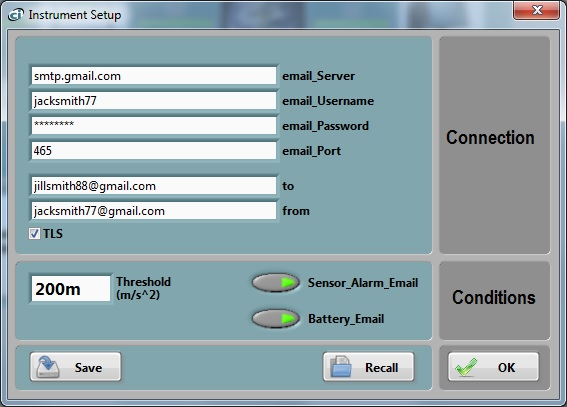Email alarms can be setup by pressing the Set email button.

Figure 19 Email Setup
Email alarms require the following conditions:
| • | The WiFi™ setup must have already been done so the instrument can connect to a router or access point. However a connection schedule does not need to be in effect for the emails to work. |
| • | That router or access point must be connected to the internet. |
| • | The user must have an email account to use for outgoing email. A good solution is to use a gmail account. |
The email setup is not always easy. See https://convergenceinstruments.com/pdf/Gmail_Setup.pdf for details.
The complete email setup is similar to the configuration of any email application. It includes the following:
| • | Email server The internet name of the outgoing email server. For gmail this is smtp.gmail.com |
| • | Port number The TCP port number of the email service. This is usually: |
| o | 25 for an “open” (no security) account. |
For gmail this is port 587 or 465.
| • | User-name The account name. For gmail it is the user’s account name (part of the email address to the left of the @ sign). |
| • | Password The account password (leave blank for an “open” (no security) account). For gmail, this is the password to gain access to the account. |
| • | TLS The encryption setting. This is the only secure mode supported. Uncheck for an “open” (no encryption) account. For gmail this should be set. |
In addition to these settings, the email alarms settings let you set:
| • | One Recipient The recipient line (to line in Figure 19). |
The application by default shows the settings for a fictitious secure gmail account (see Figure 19). These settings of course need to be changed to reflect the user’s own email account settings and recipient email address.
In addition see https://convergenceinstruments.com/pdf/Gmail_Setup.pdf for addtional settings of the gmail account itself.
Two types of alarms can be sent:
| • | An alarm when a threshold is exceeded. That threshold works exactly the same way as the AutoRec threshold. If it is set to the same value as the AutoRec threshold, the instrument will both start a recording of the signals, and send an email when the signal goes above the threshold. |
| • | An alarm when the battery level is too low. The level cannot be adjusted. It is set so the instrument has enough reserves to send the alarm. |

